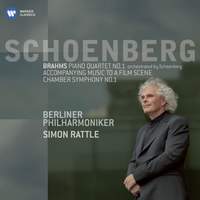Recording of the Week,
Brahms/Schoenberg from Rattle and the Berliner Philharmoniker
The latest release from Simon Rattle and the Berlin Philharmonic has the name Schoenberg in bold capital letters across the cover. Actually the major work on the disc is Brahms’s Piano Quartet in G minor, Op. 25, and while it is heard here in the Schoenberg orchestration, it is still very much Brahms’s composition and will I imagine appeal as much to lovers of Brahms as it will to lovers of Schoenberg.

Dating from 1937, Schoenberg did his arrangement relatively late in his career, and while elements of Brahms style (particularly tonal organisation and motivic development) are discernable in his early works, there is no evidence of it in his own compositions of this period. But he loved Brahms, and when asked why he had done the arrangement, his simple and rather modest answer was:
“1) I like this piece; 2) It is seldom played; 3) It is always played badly, because the better the pianist, the louder he plays and you hear nothing from the strings. I wanted once to hear everything, and this I achieved.”
He went on to add that his intention was to write his orchestration strictly in the style of Brahms, going no further than Brahms would have gone “if he had lived today”. While he doesn’t change a note of Brahms’s score, this question of writing in the style of Brahms but if Brahms was alive in 1937 is a difficult one to judge. He certainly goes far beyond Brahms’s own style in the chromatic brass writing for example, and the use of the xylophone and glockenspiel as well as techniques like trombone glissandos in the last movement are all very un-Brahmsian. But who knows what Brahms would have used if he was alive in 1937?
Either way the result I think is tremendous and hugely effective. And presumably so does Rattle as this is actually his second recording of the work (his first dating from 1985 with the CBSO). What this orchestration does demonstrate beyond all doubt is the symphonic quality of Brahms’s original work, and while from sketches to finishing touches it took him 21 years to compose his First Symphony (it was finished in 1876), on this evidence it certainly wasn’t the scale of writing such a work which held him back.
Recorded in concert back in late October/early November 2009, this new recording came quite soon after the same orchestra and conductor had recorded the composer’s Complete Symphonies and with the same warmth of string sound, articulate and well-balanced wind and brass, long phrases and real beauty of tone, this makes a compelling case for the work. Rattle moulds the score carefully to keep intensity and drama throughout but also relax and breathe in the more tender moments.
On this new recording the work is coupled with Schoenberg’s Begleitungsmusik zu einer Lichtspielszene (Accompanying Music to a Film) and the full orchestra version of the Chamber Symphony No. 1. For those maybe new to Schoenberg and perhaps slightly ‘wary’ of his works in general, the First Chamber Symphony is perhaps a good place to start. Although this recording is of the composer’s final orchestral version dating from 1935, the work itself originally began life much earlier in a version for 15 players in 1906 (less that 10 years after Brahms died). It is much more approachable to new listeners than his atonal and twelve-tone works of later periods and while fairly chromatic it is still very much romantic in style. It receives the same meticulous attention and warmth of sound from Rattle and his orchestra as the Piano Quartet.
There are videos of extracts from both works via the links below as well as the usual sound samples. Enjoy!
Berliner Philharmoniker, Sir Simon Rattle
Available Formats: MP3, FLAC, Hi-Res FLAC



